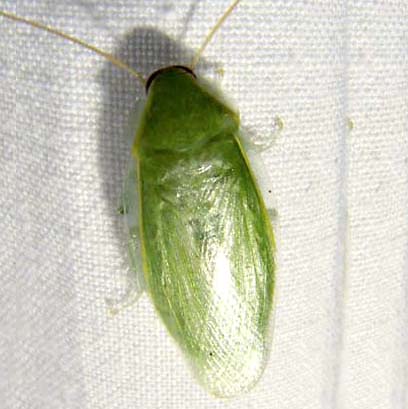Panchlora nivea
Green Banana Cockroach / Cuban Cockroack
Class: Insecta
Order: Blattodea
Family: Blaberidae

Photographer: Copyright © 2008 Robert Lord Zimlich
Source: http://bugguide.net/node/view/212520
Description
Adult Description: The Cuban Cockroach (Panchlora nivea) are 20-25mm in length, but on occasion can be as long as 50mm. Panchlora nivea are bright green in color with a yellow margin on the anterior portion of the elytra.
Larva Description: During the nymph stage P. nivea are black or dark brown in color, and takes about 100 days to mature and take on the appearance of the adult.
Host Plant: Panchlora nivea is known to infest banana trees and is not considered an indoor pest.
Ecological Threat: Panchlora nivea are considered a minimal pest due to its inability to develop and reproduce indoors. Outside they can be considered a pest due to high density in areas where firewood or leaf piles are kept. Currently the only known agricultural threat is to banana plants when populations increases to high densities.
Biology: Female P. nivea give birth to an average of 30 nymphs at one time. The eggs develop within the abdominal cavity of the female Cuban Cockroach which is large enough for the eggs to undergo postnatal development, and emerge in the nymph stage. The eggs develop within the female for about 2 months.
History: It is believed that P. nivea spread from Cuba to the United States with shipments of bananas by mistake. The Cuban Cockroach can also be purchased as a pet in the United States and has spread through incidental escapes.
U.S. Habitat: Panchlora nivea is not usually found indoors unless kept as a pet. Outside the Cuban Cockroach can be found in trees, shrubs, herbaceous plants, piles of lumber, piles of leaves, and mulch.
Distribution
Native Origin: Cuba
U.S. Present: Currently, the Cuban Cockroach is established in the Southern United States near the gulf, but most abundant in Florida.
Texas: Eastern Texas from the gulf coast to Central Texas
Resembles/Alternatives
Management
The Cuban Cockroach is attracted to light and active during the night hours, therefore keeping outside lights off when possible prevents further establishment of the Cuban Cockroach. Also, P. nivea establishment can be discouraged by scattering wood piles and disposing of leaf piles to remove the ideal habitat for this cockroach.
SEARCH Online
Google Search: Panchlora nivea
Google Images: Panchlora nivea
NatureServe Explorer: Panchlora nivea
Bugwood Network Images: Panchlora nivea
References
Roth, Louis, and Edwin Willis. 1957. The Biology of Panchlora nivea, with Observations on the Eggs of Other Blattaria. American Entomological Society. 83(4):195-207.
Roth, Louis, and Robert Barth. 1964. The control of sexual receptivity in female cockroaches. Journal of Insect Physiology. 10(6):965-975.
Willis, Edwin. 1965. Biology and Behavior of Panchlora irrorata, a Cockroach Adventive on Bananas (Blattaria: Blaberidae). Annals of the Entomological Society of America. 59.(3):514-516.
Internet Sources
http://bugguide.net/node/view/31689
http://www.itis.gov/servlet/SingleRpt/SingleRpt
 Texas Invasive Species Institute
Texas Invasive Species Institute